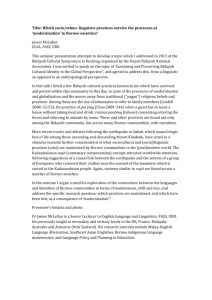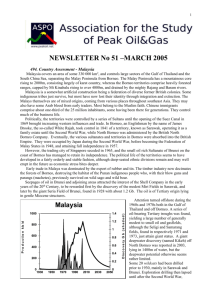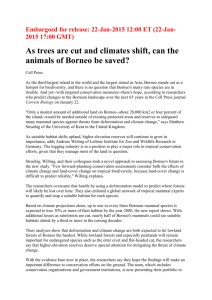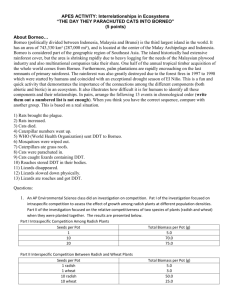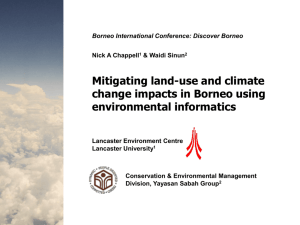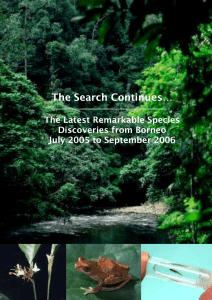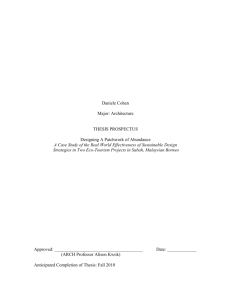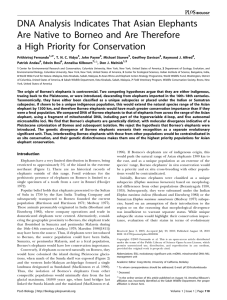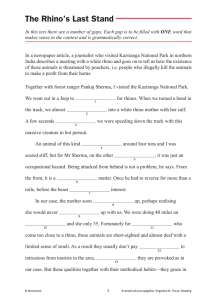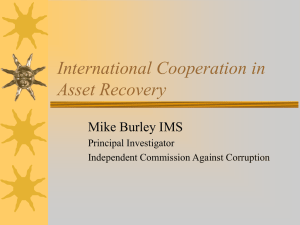The Borneo biome - 18-108
advertisement
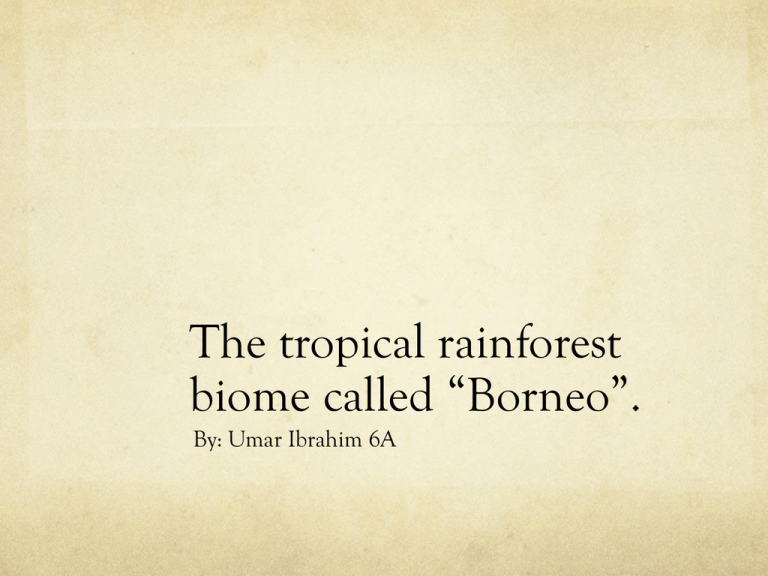
The tropical rainforest biome called “Borneo”. By: Umar Ibrahim 6A Map of Borneo http://maps.google.com/maps?q=Three+animals+in+Borneo& um=1&ie=UTF-8&hl=en&sa=N&tab=wl Brief description Borneo is the 3rd largest island in the world. It is known to be really rich in biodiversity compared to other rainforests/jungles/islands etc. It also holds the 20th largest mountain in the world. Which is called Mount Kinabulu. http://en.wikipedia.org/wiki/Borneo http://www.climbingmountkinabalu.com/ Abiotic factors The average rainfall for Borneo is 3295mm It can start to rain hard but the hard rain doesn’t last for a long duration. Sabah a place in Borneo doesn’t really have wet or dry seasons. It is normally warm throughout the year, but sometimes it can have tropical rain showers and storms. http://www.borneo-hotels.com/info/weather.htm Plants Rafflesia arnoldii –It grows as a flower without any leaves. This plant gets its food from the vine that it grows on. Nepenthes- This plant isn’t a normal plant. This is because they are carnivorous plants. They have digestive fluids and water inside their pitcher and when a fly falls in the fluids it will become food for the plant. Lianas-This plant is a vine, starting life on the ground. It needs its sunlight so it uses other plants for support to get to the canopy, they mostly use the trees. http://www.ehow.com/list_7377291_plants-borneo-rain-forests.html Lianas- Pictures of the plants Nepenthes- Rafflesia Arnoldii- Lianas: http://www.tutorvista.com/biology/plants-in-a-tropical-rainforest Nepenthes: http://en.wikipedia.org/wiki/File:Nepenthes_villosa.jpg Rafflesia arnoldii: http://www.thegorgeousdaily.com/rafflesia-arnoldii/ Animals Sun bear-These animals are known to be nocturnal and omnivorous, feeding on a range of different producers and animals. They have immensely large claws for climbing trees and a long tongue to eat honey with. Clouded leopard- These animals live in tropical forests. They have 2 inched canines, and feed on deers, birds porcupines etc. Banteng- These animals are related to the cattle except that they are wild. They feed on leaves, branches and grass. They are known to be nocturnal to avoid hunters. http://www.konicaminolta.com/kids/endangered_animals/library/fiel d/banteng.html http://www.mongabay.com/borneo/borneo_wildlife.html Pictures of the animals Banteng- Clouded Leopard- Sun bear- Clouded Leopard: http://animals.nationalgeographic.com/animals/mammals/cloudedleopard/ Banteng: http://khoirs.blogspot.com/ Sun bear: http://www.flwblog.com/2011/07/malayan-sun-bear-animalpictures/ What minerals or medicines can be found in Borneo? Minerals: Coal Gold Borneo is said to be extremely rich with two minerals, Coal and Gold. Borneo also contains natural gas. But is not known to be rich because of natural gas. http://www.wwf.org.uk/what_we_do/safeguarding_the_natural_world /forests/forest_work/borneo_forest/ http://www.indonesia-tourism.com/forum/showthread.php?31-The-Very-RichEast-Borneo Pictures of minerals Coal- Gold- http://www.etftrends.com/2012/01/gold-etfs-size-up-200day-average-as-dollar-weakens/ http://www.mii.org/Minerals/photocoal.html How has science helped? Science has helped because science’s role play is to experiment with the items we find such as: gold, coal, tin iron etc, and while experimenting with it, finding out whether or not it can be used as a resource to help us. And that is what science is doing and has done. Human activities The first human activity in Borneo is logging. This is cause by the fact that some societies cant afford to get a job, so they cut down trees and sell them. The trees are then used for furniture such as: tables, chairs, drawers etc. The second human activity is the destruction of the habitats, this is sort of related to logging. Except its for a different reason which is to clear an area to expand accommodations, hospitals, parks etc. The last human activity is poaching. Poaching is when you kill an animal either for fun or for a reason. A reason of why people do this is for their fur and horns. Bibliography for human activities http://save-the-trees.tripod.com/id2.htmlhttp:// bushwarriors.wordpress.com/tag/rhino-hornsmugglers/ http://www.sciencelives.com/logging.html How does the use of natural resources affect economics, societies etc? Logging- Logging will soon affect Borneo’s societies because if there aren’t any trees in parts of Borneo then less oxygen will be able to come around societies. Destruction of habitat- If this problem continues on then soon there wont be any habitats to cut down, so societies wont have enough money for several things because there money is also going to be used for buying and trading. Poaching- If this carries on animals soon the trigger off the food chain. Then the other species have less to eat, and if more animals are extinct food will be scarce for carnivores. Did you know… Did you know that a man had injected poison into a few rhinos, into their horns. He did this because the Chinese thought that the horns had medicinal properties, but they don’t. And he wanted the poaching of rhino’s to stop. So whoever uses the horns for a cure will get poisoned and eventually die. The poison wont affect the rhinos because the rhinos horns don’t have blood vessels to carry the poison around their body. http://blogs.scientificamerican.com/extinctioncountdown/2010/09/01/toxic-avenger-one-mans-desperateidea-to-save-the-rhinos-poison-their-horns/ That’s the end of my presentation!
